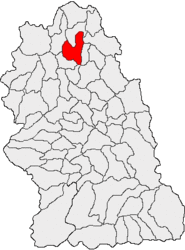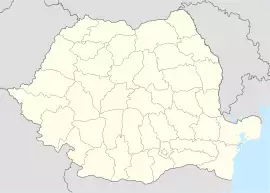Brad | |
|---|---|
Municipality | |
 Location in Hunedoara County | |
| Coordinates: 46°7′46″N 22°47′24″E / 46.12944°N 22.79000°E | |
| Country | |
| County | Hunedoara |
| Government | |
| • Mayor | Florin Cazacu[1] (PSD) |
| Area | 79.98 km2 (30.88 sq mi) |
| Population (2011)[2] | 14,495 |
| • Density | 180/km2 (470/sq mi) |
| Time zone | EET/EEST (UTC+2/+3) |
| Vehicle reg. | HD |
| Website | http://www.e-brad.ro/ |
Brad (Romanian pronunciation: [brad]; Hungarian: Brád; German: Tannenhof) is a city in Hunedoara County in the Transylvania region of Romania. Its name comes from the Romanian word brad, "fir".
Demographics
| Year | Pop. | ±% |
|---|---|---|
| 1948 | 6,210 | — |
| 1956 | 9,963 | +60.4% |
| 1966 | 15,532 | +55.9% |
| 1977 | 17,077 | +9.9% |
| 1992 | 18,861 | +10.4% |
| 2002 | 16,482 | −12.6% |
| 2011 | 14,495 | −12.1% |
| Source: Census data | ||
- Romanians - 13,534 (97.3%)
- Romani - 192 (1.38%)
- Hungarians - 127 (0.91%)
- Germans - 19 (0.13%)
- Others - 33
Geography
Brad lies in the valleys of the river Crișul Alb and its tributaries Brad and Luncoiu. Five villages are administered by the city: Mesteacăn ("birch"; Mesztákon), Potingani (Pottingány), Ruda-Brad (Ruda), Țărățel (Cerecel) and Valea Bradului ("the valley of the fir tree"; Vályabrád).
History
A gold mine in the area began to be exploited in Roman times, and the town developed around it. The earliest documentary mention of Brad dates to 1445. Gold mining was active until 2006. There is a Gold Museum.
Historic building
Brad railway station is listed as a historic monument.
Natives
- Cătălin Bălescu
- Ilarion Felea
- Teodor Meleșcanu
- László Pataky
- Ileana Stana-Ionescu
References
- ^ "Results of the 2016 local elections". Central Electoral Bureau. Retrieved 3 April 2020.
- ^ "Populaţia stabilă pe judeţe, municipii, oraşe şi localităti componenete la RPL_2011" (in Romanian). National Institute of Statistics. Retrieved 4 February 2014.

